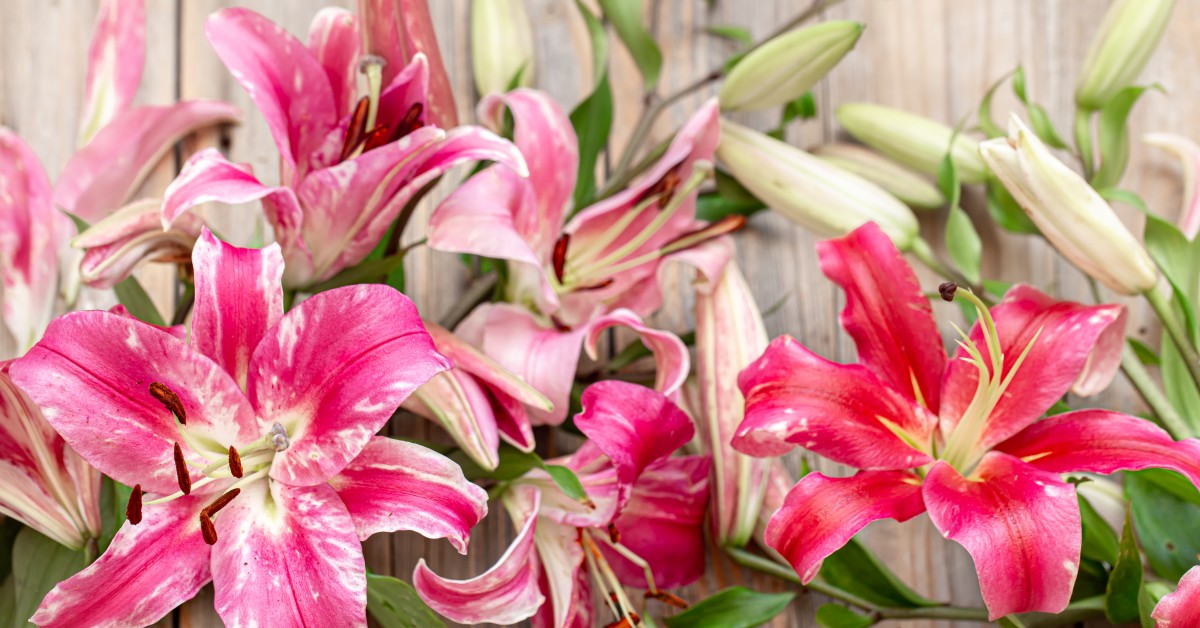Keep These Spring Plants Away from Your Pets
Keep your pets safe this spring by keeping them away from toxic plants and flowers.

Spring flowers can instantly brighten up your home and yard. Unfortunately, they pose certain dangers in homes with pets. These beautiful blooms often contain toxins that can be poisonous to animals if ingested, causing symptoms like lethargy, vomiting, and in severe cases, death. The best way to keep your pet safe from toxic plants is to avoid them altogether.
Let’s take a look at some of the most common plants that are toxic to pets and how to approach pet-friendly gardening.
Spring Plants and Flowers
Spring is here, prompting many people to plant flowers in their yard and bring freshly picked bouquets indoors. While many spring plants and flowers pose no harm to animals, others can be harmful to pets. To promote springtime safety for your furry companions, avoid the following poisonous plants:
1. Lilies
Many types of lilies can make pets sick. Some lily species only produce mild symptoms, making your pet feel generally unwell. These include species like peace lilies, flame lilies, lily of the valley, calla lilies, and Peruvian lilies. Other lily varieties, such as easter lilies, stargazer lilies, tiger lilies, Japanese lilies, and daylilies, can be more toxic, leading to serious symptoms like diarrhea, vomiting, and anorexia.
2. Daffodils
Daffodils are poisonous to both cats and dogs. Both the bulbs and the flowers themselves have toxic properties, and even drinking the water from a vase with these flowers inside can be harmful to your pet’s health. If ingested, you may notice that your pet is wobbly or very sleepy. Some animals will have “fits” or experience upset stomach and vomiting. Avoid planting daffodils in your yard or garden, as dogs will often dig them up, putting their health at risk.
3. Azaleas
While beautiful and colorful, azaleas are a dangerous flowering shrub when it comes to animals. Closely related to the Rhododendron family, these plants contain neurotoxin grayanotoxin, which can prevent body cells from returning to normal after experiencing excitation. Pets that consume these flowers often experience low blood pressure, tremors, and abnormal heart rhythms. Ingestion can also interfere with nerve and skeletal functions.
4. Sago Palms
Sago palms, also known as coontie palms, are pretty to look at but have hidden dangers. All parts of this plant are poisonous to animals, but the seeds are the most toxic. Consuming even a small amount of the seeds can cause severe side effects in cats and dogs. Common clinical signs of sago palm poisoning include gastrointestinal upset and lethargy, often within the first few hours after consumption. Over the next few days, the animal may have increased liver enzymes and possible liver failure.
5. Tulips
Although one of the most popular spring flowers, tulips can be dangerous in households with pets. They contain a substance known as glycoside, which is especially concentrated in the bulb of the plant, causing symptoms like breathing difficulties and elevated heart rate. They also contain other toxins, such as Tulipalin A and Tulipalin B, both of which can cause poisoning symptoms within a few hours of ingestion.
6. Snowdrops
Snowdrop flowers come from a group of more than 20 perennial species with bell-shaped white flowers. What makes these plants toxic is that they contain alkaloid galantamine, which can cause mild to moderate toxicity. Pets who consume snowdrops may experience diarrhea and vomiting in low amounts. Those who consume more of the plant may have slowed heart rate and lowered blood pressure.
7. Rhododendrons
While a common garden staple, rhododendrons are considered highly toxic to pets. Just a few small bites of this plant, whether it be the petals, stems, leaves, or pollen, can result in serious symptoms that require medical intervention. If you suspect that your pet has ingested this plant, it’s essential to contact your veterinarian immediately.
8. Amaryllis
Another common spring flower harmful to animals is amaryllis. This plant contains a toxic known as lycorine, an alkaloid often found in Amaryllidaceae species. It can be found in all parts of the plant, including the petals, leaves, and stems. If your cat or dog eats enough of it, they may exhibit symptoms like lethargy, excessive drooling, tremors, loss of appetite, respiratory depression, diarrhea, and vomiting.
9. Bluebells
Bluebells are a beautiful addition to any garden but caution should be taken if you have animals. These flowers contain a potent toxin called glycoside which can harm the heart and if left untreated, could be fatal. Bluebells generally go into full bloom from spring to early summer and are most common in woodland areas.
10. Crocuses
Another type of plant to be wary of in the spring is crocuses. However, you don’t want to get the different types of crocuses confused. The first type blooms in the spring and is known as the crocus species, while the other blooms in the fall and is referred to as Colchicum autumnale. If the springtime flowers are consumed by pets, they can cause gastrointestinal upset, including diarrhea, vomiting, and drooling.
Keep Your Pet Protected this Spring
If you suspect that your cat or dog may have been poisoned by spring plants or flowers, contact animal poison control or your local veterinarian as soon as possible. Always take the time to research what plants you’ll be adding to your home or garden to keep your pets safe and healthy.
Ready to start saving money on pet wellness care?
Then take a look at Mint Wellness, the pet wellness plan that provides fast reimbursement on routine pet care. Save on vaccinations, wellness exams, preventatives, dental, and more!
Learn More